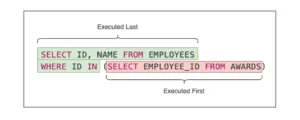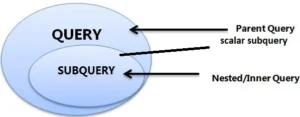Subqueries & Nested Queries
What is a Subquery?
A subquery (also called a nested query) is a query written inside another query. It is used to return data that will be used by the main (outer) query.
Subqueries can be used in:
- SELECT
- WHERE
- FROM
- HAVING clauses
They help break down complex problems into simpler queries.
Types of Subqueries
1. Single-row Subquery
Returns only one row from the inner query.
Example:
This query returns the name of the student who is the oldest.
2. Multiple-row Subquery
Returns multiple rows, often used with operators like IN, ANY, or ALL.
Example:
This returns names of students whose department is located in Mumbai.
3. Correlated Subquery
A correlated subquery is executed once for each row of the outer query. It uses values from the outer query.
Example:
This finds students older than the average age in their department.
4. Nested Subquery
A subquery within another subquery.

This query finds students who belong to a department located in Pune.
Subqueries vs Joins
Subqueries: Better for modular and readable queries, especially when filtering.
Joins: Better for retrieving data from multiple related tables in a single flat result set.
Use Cases of Subqueries
- Filtering records using values from another table
- Calculating values (like MAX, MIN, AVG) to use in a condition
- Creating dynamic condition sets
- Replacing complex joins when only filtering is required
